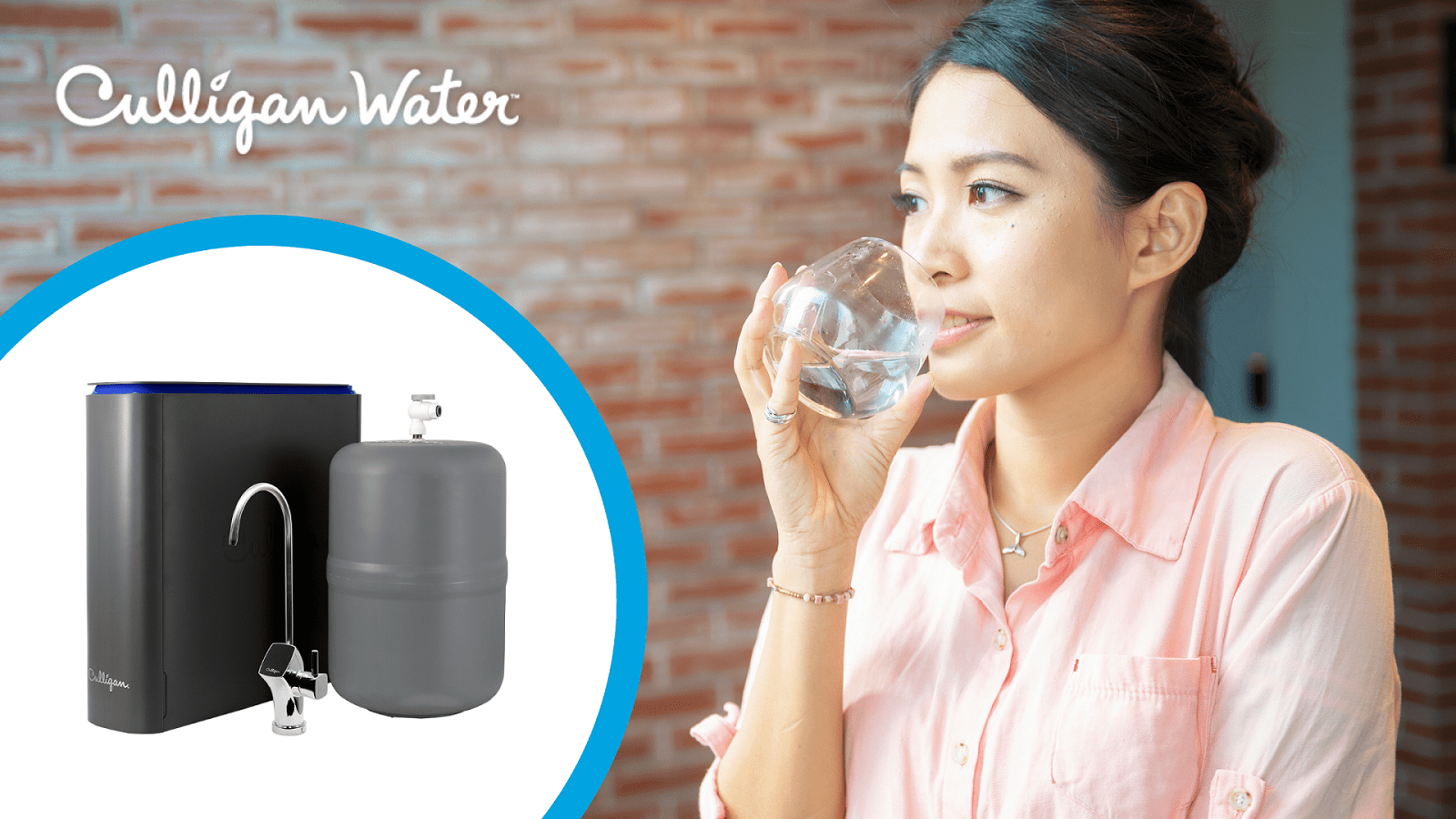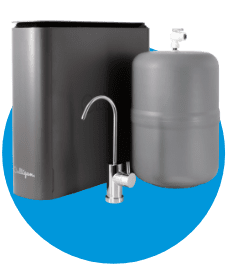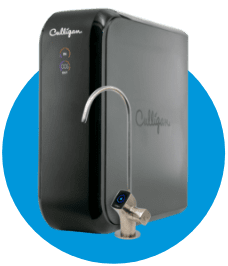Frequently Asked Questions About Reverse Osmosis Drinking Water Systems
Find answers to common questions asked about reverse osmosis drinking water systems, including function, benefits, installation and maintenance.
Posted in
Culligan Nation,
Culligan Solutions,
Drinking Water System,
Reverse Osmosis,
Water Problems,
Water Treatment

What’s in your drinking water? Find out with our free water test from your local Culligan water expert.
Are you thinking about getting a reverse osmosis (RO) drinking water system but you’re not sure how they work? Do you wonder what reverse osmosis even is, or are you concerned about the safety of your drinking water?
In this article, we’ll explore the ins and outs of RO, including:
- What is reverse osmosis?
- How does a reverse osmosis drinking water system work?
- What are the benefits of a reverse osmosis drinking water system?
- How does reverse osmosis compare to other household water filters?
- What are some of the contaminants that reverse osmosis systems reduce?
- Is reverse osmosis water safe to drink?
- What is the difference between reverse osmosis and distilled water?
- Does a reverse osmosis drinking water system require maintenance?
- What are the most popular Culligan reverse osmosis drinking water systems?
Read on to learn everything you need to know about RO.
Reverse Osmosis Drinking Water System FAQs
What is reverse osmosis?
Reverse osmosis is a process that significantly reduces contaminants, solid substances, large molecules and minerals from water by using pressure to push it through specialized membranes. It is a purification method used to improve water for drinking, cooking and other household uses.
How does reverse osmosis work?
The key to understanding reverse osmosis is first understanding the process of osmosis.
Osmosis is defined as the passage of a solvent, such as water, from a lower-concentration solution to a higher-concentration solution. A semipermeable membrane separating the two solutions allows the solvent to pass. But not what is dissolved in it. The flow finally stops when both solutions become equal in concentration. This process is classified as passive transport, because it does not require energy to be applied.
Now, here’s how reverse osmosis works:
- Unlike osmosis, which is a passive process, reverse osmosis requires an external force, or pressure, to work.
- Pressure is applied to a highly concentrated solute solution, such as saltwater. So it can pass through a membrane and turn into a less concentrated solution.
- The membrane allows water to flow through but it blocks out larger molecules, like contaminants.
- The reverse osmosis process leaves higher concentrations of solute on one side and only the solvent, or filtered water, on the other.
How does a reverse osmosis drinking water system work?
There are four distinct steps in reverse osmosis water filtration — pre-filtration, reverse osmosis, drainage and storage.
- Pre-filtration: Water passes through a particle filter and activated carbon filter. And reduces impurities like salt, sediment, chlorine, mercury, copper and pesticides.
- Reverse osmosis: Pressurized water is forced through a semipermeable membrane. This traps the smallest impurities and allows only water to pass through.
- Drainage: The removed contaminants are flushed away while treated water moves to a storage tank.
- Storage: Before the treated water reaches a faucet, it undergoes a final activated-carbon filtration to improve the taste and quality for household use.
What are the benefits of a reverse osmosis drinking water system?
Reverse osmosis drinking water systems offer a number of benefits for you and your home.
A Culligan RO drinking water system gives you:
- Cleaner, safer drinking water
- Better-tasting food and beverages
- Unlimited supply of great-tasting water
- Less plastic bottles in landfills
On top of that, an RO drinking water system from Culligan water comes with unbeatable expertise and customer service backed by the best warranty in the business.
How does reverse osmosis compare to other household water filters?
Your home might currently rely on water treatment methods such as refrigerator filters, pitcher filters or faucet filters. These options are effective at improving taste and reducing sediment or other particles found in drinking water. But they don’t address dissolved solids, arsenic, viruses and bacteria.
Reverse osmosis, on the other hand, can reduce up to 99% of contaminants found in drinking water. This includes larger particles and those that you can’t always see, taste or smell.
What are some of the contaminants that reverse osmosis systems reduce?
Culligan reverse osmosis drinking water systems are customizable, with 12 interchangeable filters. They are certified to reduce up to 60 water contaminants unique to your household, including:
Is reverse osmosis water safe to drink?
Yes, reverse osmosis water is a safe drinking water option for your household. The Water Quality Association has concluded that water treated with a reverse osmosis drinking water system does not pose any health concerns for healthy individuals. Consuming reverse osmosis water can help minimize health risks associated with potentially harmful substances that are sometimes found in drinking water.
While reverse osmosis may reduce the amount of minerals found in your drinking water, many RO systems allow for the use of remineralization solutions. Culligan’s Mineral Boost Cartridge, for instance, is a great option if you want to add back select minerals or increase your drinking water’s pH.
What is the difference between reverse osmosis and distilled water?
Reverse osmosis is a water treatment process that reduces contaminants in water. This is done by using pressure to force the water molecules through a semipermeable membrane.
On the other hand, distilled water is treated by passing through one or more evaporation-condensation cycles until it contains a very low amount of dissolved solids (usually less than 5.0 ppm TDS).
Distilled and reverse osmosis water are both commercially available. However, reverse osmosis is more commonly used in home treatment systems. While some households opt to install a home distillation solution, these systems tend to be less convenient. And they usually require more energy and owner involvement to run.
Where is a reverse osmosis drinking water system installed?
RO systems are usually installed under the kitchen sink, or sometimes in the basement.
Here are a few tips to keep in mind when determining the right location for your RO system:
- The system should be out of the way but still accessible to your home’s water lines. For most people, this means under the kitchen sink.
- Make sure that when you settle on a spot, it’s in an area that won’t be exposed to freezing temperatures that could damage the system.
- Depending on the type of RO system you choose to install, there are drain proximity, electrical and piping connection requirements – all things that your Culligan water expert will help you with during installation.
With a Culligan RO drinking water system, you don’t need to worry about logistics like installation. Your local Culligan water experts will deliver, install and maintain your reverse osmosis filtration system for you, so you don’t have to!
Does a reverse osmosis drinking water system require maintenance?
Yes, the performance and longevity of your reverse osmosis system will be impacted by regular maintenance. However, top-performing reverse osmosis filtration systems tend to require little ongoing effort.
At a minimum, you should plan to change your filters every 1-2 years. You should also make sure your reverse osmosis drinking water system is sanitized once a year.
Selecting your reverse osmosis system from an industry-leading manufacturer and service partner will ensure that your system runs efficiently. Your local Culligan water experts are equipped to handle every aspect of maintenance and ongoing care.
From installation to filter changes and sanitization appointments, Culligan ensures that all parts continue working properly so you can provide your household with safer, better-tasting water.
What are the most popular Culligan reverse osmosis drinking water systems?
Culligan’s reverse osmosis systems are designed to make it easy for you to enjoy safer, cleaner water at home. Whether you want an endless supply of RO water or your priority is for a compact design that fits seamlessly into your home, we can help find the best system for you.
Below are a few of the most popular Culligan reverse osmosis drinking water systems.

Culligan® Aquasential® Reverse Osmosis Drinking Water System:
- Up to seven stages of filtration with 12 interchangeable filters
- Certified to reduce 60 different contaminants
- Unlimited supply of safer water for just pennies a glass
- Smart option available

Culligan® Aquasential® Tankless Reverse Osmosis Drinking Water System:
- Elegant, space-saving design
- Four stages of filtration reduces contaminants by 95%
- Unlimited supply of safer water for just pennies a glass
- Smart option available
Getting Started
Whether you want to support the environment, make safer drinking water choices for your family or save time and money, reverse osmosis water can help you accomplish your goals.
With a Culligan water RO system, you can ensure your family members are getting the high-quality water they deserve.
For more information about water softening or Culligan water products, contact your local Culligan water expert or schedule a free water test today!
*Contaminants may not be in your water.

